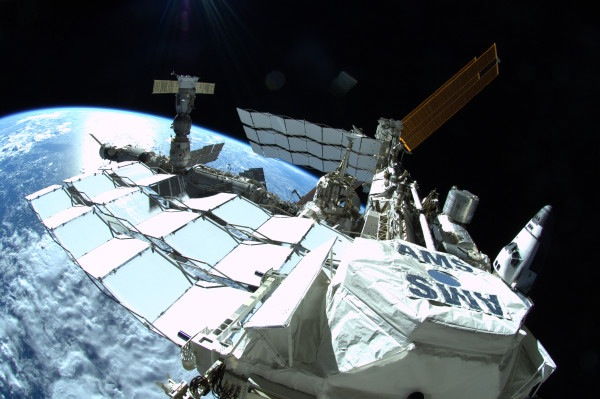Potential Dark Matter Discovery a Win for Space Station Science

If nature is kind, the first detection of dark matter might be credited to the International Space Station soon.
Today (April 3), researchers announced the first science results from the Alpha Magnetic Spectrometer (AMS), a $2 billion cosmic-ray particle detector mounted on the exterior of the football-field-size International Space Station. The instrument has observed a striking pattern of antimatter particles called positrons that may turn out to be a product of collisions between dark matter particles.
Though the findings are still uncertain, and the signal could also arise from a more mundane source, the data are, nonetheless, groundbreaking, experts said.
"I think it is fair to say that this is the most important physics result thus far to come from the International Space Station," theoretical physicist Robert Garisto, who was not involved in the AMS project, wrote today on Twitter. [Photos: See the Alpha Magnetic Spectrometer in Space]
Garisto is editor of the physics journal Physical Review Letters, which published the AMS results in a paper released today.
No matter what the AMS measurements ultimately herald — be it dark matter or something else — the findings would not have been possible without the platform of the International Space Station, a $100 billion orbiting laboratory staffed full-time by teams of three to six astronauts. AMS collects cosmic-ray particles, which are abundant in space, though largely blocked on Earth by our planet's atmosphere.
In its first 18 months of operations, AMS detected about 30 billion cosmic rays, including 400,000 positrons — a haul that allowed significantly more precise statistics than experiments conducted on Earth.
Get the Space.com Newsletter
Breaking space news, the latest updates on rocket launches, skywatching events and more!
"It's a very major step forward by at least an order of magnitude in sensitivity," Brown University physicist Richard Gaitskell told SPACE.com. Gaitskell is a founding investigator on the Large Underground Xenon experiment, which aims to detect dark-matter particles directly underground in South Dakota.
Dark matter is an invisible substance thought to make up more than 80 percent of the matter in the universe. The elusive stuff is difficult to detect because it very rarely interacts with normal matter, except through its gravitational pull.
One of the leading explanations for dark matter is that it is made up of particles called WIMPs (weakly interacting massive particles), which may produce a detectable signature when they collide and annihilate each other. This happens because WIMPs are thought to be their own antimatter partner particles. When matter and antimatter meet, they destroy each other, so if two WIMPs were to make contact, they would obliterate one another.
In fact, searching for this signature of WIMPs was one of the main motivations for building the Alpha Magnetic Spectrometer. Whether or not the instrument succeeds in detecting dark matter, scientists say they're happy with the early results from AMS so far.
"I am confident that this is only the first of many scientific discoveries enabled by the station that will change our understanding of the universe," NASA administrator Charles Bolden said today in a statement.
However, the experiment almost never made it to space.
The first space shuttle mission slated to deliver AMS to orbit was canceled in the wake of the 2003 space-shuttle Columbia disaster, and it took a prolonged campaign by scientists to convince NASA to add a final shuttle mission to its schedule before the fleet was retired. Finally, in May 2011, the space-shuttle Endeavour carried AMS to the space station in the second-to-last mission of the 30-year shuttle program.
"I think there's probably a message to all of us: When it looks kind of dark and doesn't look like there's a clear path forward, fix your eyes on that point in the future, and keep moving forward," William Gerstenmaier, NASA's space station program manager, said during a NASA press conference today. The great results from AMS now are perhaps "just a tad sweeter that way" than if the road to this point had been less turbulent, he added.
Follow Clara Moskowitz on Twitter and Google+. Follow us @Spacedotcom, Facebook and Google+. Original article on SPACE.com.
Join our Space Forums to keep talking space on the latest missions, night sky and more! And if you have a news tip, correction or comment, let us know at: community@space.com.

Clara Moskowitz is a science and space writer who joined the Space.com team in 2008 and served as Assistant Managing Editor from 2011 to 2013. Clara has a bachelor's degree in astronomy and physics from Wesleyan University, and a graduate certificate in science writing from the University of California, Santa Cruz. She covers everything from astronomy to human spaceflight and once aced a NASTAR suborbital spaceflight training program for space missions. Clara is currently Associate Editor of Scientific American. To see her latest project is, follow Clara on Twitter.









